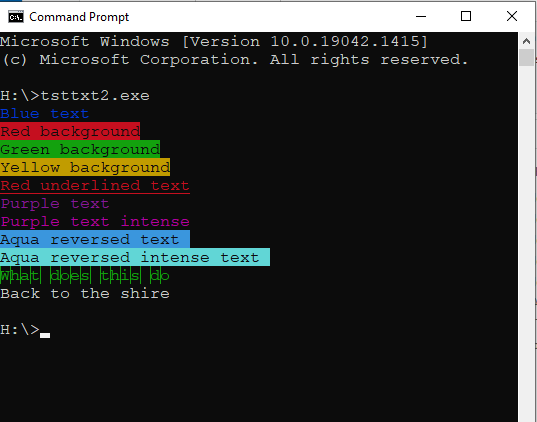I found this question and thought I would add to the answers for pre-windows 10 terminal using kernel32 functions,
using System;
using System.Runtime.InteropServices;
namespace color_console
{
class Class1
{
static void Main(string[] args)
{
Class1 c = new Class1();
c.change();
}
[DllImport("kernel32.dll", SetLastError=true)]
public static extern bool SetConsoleTextAttribute(IntPtr hConsoleOutput, CharacterAttributes wAttributes);
[DllImport("kernel32.dll")]
public static extern IntPtr GetStdHandle(int nStdHandle);
[DllImport("kernel32.dll")]
public static extern bool GetConsoleScreenBufferInfo(IntPtr hConsoleOutput,
ref CONSOLE_SCREEN_BUFFER_INFO lpConsoleScreenBufferInfo);
void change()
{
const int STD_OUTPUT_HANDLE = -11;
IntPtr hOut;
hOut = GetStdHandle(STD_OUTPUT_HANDLE);
CONSOLE_SCREEN_BUFFER_INFO ConsoleInfo = new CONSOLE_SCREEN_BUFFER_INFO();
GetConsoleScreenBufferInfo(hOut, ref ConsoleInfo);
CharacterAttributes originalAttributes = (CharacterAttributes)ConsoleInfo.wAttributes;
//write some text
SetConsoleTextAttribute(hOut, CharacterAttributes.FOREGROUND_BLUE);
Console.WriteLine("Blue text");
SetConsoleTextAttribute(hOut, CharacterAttributes.BACKGROUND_RED);
Console.WriteLine("Red background");
SetConsoleTextAttribute(hOut, CharacterAttributes.BACKGROUND_GREEN);
Console.WriteLine("Green background");
SetConsoleTextAttribute(hOut, CharacterAttributes.BACKGROUND_GREEN | CharacterAttributes.BACKGROUND_RED);
Console.WriteLine("Yellow background");
SetConsoleTextAttribute(hOut, CharacterAttributes.FOREGROUND_RED | CharacterAttributes.COMMON_LVB_UNDERSCORE);
Console.WriteLine("Red underlined text");
SetConsoleTextAttribute(hOut, CharacterAttributes.FOREGROUND_RED
| CharacterAttributes.FOREGROUND_BLUE);
Console.WriteLine("Purple text");
SetConsoleTextAttribute(hOut, CharacterAttributes.FOREGROUND_RED
| CharacterAttributes.FOREGROUND_BLUE
| CharacterAttributes.FOREGROUND_INTENSITY);
Console.WriteLine("Purple text intense");
SetConsoleTextAttribute(hOut, CharacterAttributes.FOREGROUND_GREEN
| CharacterAttributes.FOREGROUND_BLUE
| CharacterAttributes.COMMON_LVB_REVERSE_VIDEO);
Console.WriteLine("Aqua reversed text ");
SetConsoleTextAttribute(hOut, CharacterAttributes.FOREGROUND_GREEN
| CharacterAttributes.FOREGROUND_BLUE
| CharacterAttributes.COMMON_LVB_REVERSE_VIDEO
| CharacterAttributes.FOREGROUND_INTENSITY);
Console.WriteLine("Aqua reversed intense text ");
SetConsoleTextAttribute(hOut, CharacterAttributes.COMMON_LVB_GRID_LVERTICAL
| CharacterAttributes.FOREGROUND_GREEN);
Console.WriteLine("What does this do");
SetConsoleTextAttribute(hOut, originalAttributes);
Console.WriteLine("Back to the shire");
}
public enum CharacterAttributes
{
FOREGROUND_BLUE = 0x0001,
FOREGROUND_GREEN = 0x0002,
FOREGROUND_RED = 0x0004,
FOREGROUND_INTENSITY = 0x0008,
BACKGROUND_BLUE = 0x0010,
BACKGROUND_GREEN = 0x0020,
BACKGROUND_RED = 0x0040,
BACKGROUND_INTENSITY = 0x0080,
COMMON_LVB_LEADING_BYTE = 0x0100,
COMMON_LVB_TRAILING_BYTE = 0x0200,
COMMON_LVB_GRID_HORIZONTAL = 0x0400,
COMMON_LVB_GRID_LVERTICAL = 0x0800,
COMMON_LVB_GRID_RVERTICAL = 0x1000,
COMMON_LVB_REVERSE_VIDEO = 0x4000,
COMMON_LVB_UNDERSCORE = 0x8000
}
[StructLayout(LayoutKind.Sequential)]
public struct CONSOLE_SCREEN_BUFFER_INFO
{
public COORD dwSize;
public COORD dwCursorPosition;
public int wAttributes;
public SMALL_RECT srWindow;
public COORD dwMaximumWindowSize;
}
// Standard structures used for interop with kernel32
[StructLayout(LayoutKind.Sequential)]
public struct COORD
{
public short x;
public short y;
}
[StructLayout(LayoutKind.Sequential)]
public struct SMALL_RECT
{
public short Left;
public short Top;
public short Right;
public short Bottom;
}
}
}
Output on my PC
![enter image description here]()



Microsoft Windows [Version 10.0.19044.2728]it does see https://mcmap.net/q/219845/-ansi-colors-and-writing-directly-to-console-output-c for example. – Motch